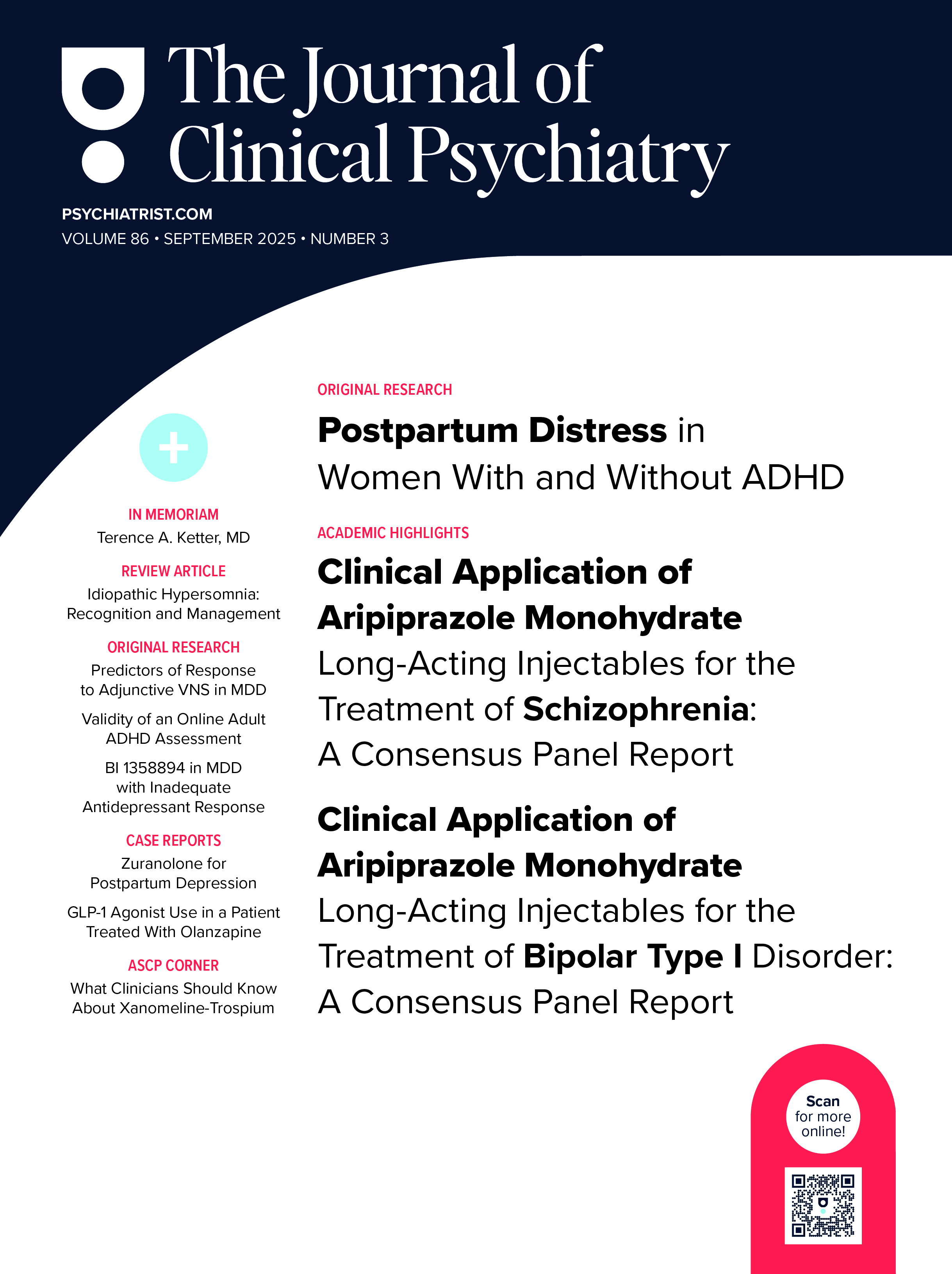Ragy Girgis, MD, MS
Professor of Clinical Psychiatry
Columbia University Irving Medical Center
New York, NY
Ragy Girgis, MD, MS, is Professor of Clinical Psychiatry at Columbia University and Director of the Center of Prevention and Evaluation (COPE), specializing in individuals at clinical high risk for psychosis. His research focuses on the dopamine system in schizophrenia, particularly the role of D3 receptors in negative and cognitive symptoms. He has led numerous clinical trials and neuroimaging studies and is recognized for advancing early intervention and novel treatment strategies in psychotic disorders.
In Part II of his series on the role of dopamine receptors in schizophrenia, Dr. Ragy Girgis expands on the emerging role of the dopamine D3 receptor in antipsychotic drug mechanism of action. He reviews imaging and binding data demonstrating how various antipsychotics, including risperidone, clozapine, and cariprazine, interact with D3 receptors in vitro, in vivo, and ex vivo. With a focus on receptor selectivity, regional binding profiles, and implications for the treatment of negative symptoms of schizophrenia, Dr. Girgis makes the case for deeper investigation into D3-preferring agents as potential tools for improving outcomes in schizophrenia.
This presentation is part of the Emerging Approaches in Schizophrenia Editorial Focus collection from Psychiatrist.com News. The collection focuses on the latest advances in schizophrenia treatment, with an emphasis on emerging therapies that go beyond traditional dopaminergic approaches.
Transcript
(0:12 – 2:17) Discrepancies in D3 Binding: In Vitro vs. In Vivo
Hello, I’m Ragy Girgis, I’m a professor of clinical psychiatry at Columbia, and today we’re going to talk about the dopamine-3 receptor and the treatment of schizophrenia. Now, in vitro data suggest that antipsychotic medications bind to both the dopamine-2 and dopamine-3 receptors. In general, the data suggests that most of the antipsychotic medications available are dopamine-2 preferring, but overall, the data are pretty clear that at least in vitro, currently available antipsychotic medications bind to both the dopamine-2 and the dopamine-3 receptor.
An interesting set of studies suggest that the way antipsychotic medications bind to the dopamine-2 and dopamine-3 receptors is different in vitro, like in culture, versus ex vivo, which is using cells or tissues outside of the body, but in conditions that simulate normal physiology. So here, what you see is that on the right side of each panel are the regions of the brain in which the dopamine-2 receptor is more prominent, and on the left side of the panel is areas of the brain in which the dopamine-3 receptor is more prominent. What these data suggest is that in vitro, we see that antipsychotic medications bind to the dopamine-2 and the dopamine-3 receptor, but ex vivo, it appears based on these data that for some reason, the same antipsychotics only bind to the dopamine-2 receptor and very little or not at all to the dopamine-3 receptor.
Several very well done pet studies have also suggested that in humans, in people with schizophrenia in particular, antipsychotic medications do not bind to the dopamine-3 receptor at all, rather they only bind to the dopamine-2 receptor. So that is one potential interpretation of the results. The other potential interpretation of the results is that the medications do bind to the dopamine-3 receptor, but cause upregulation.
(2:18 – 5:08) Binding Studies with Haloperidol, Clozapine, Risperidone & Cariprazine
So these studies demonstrate that either in vivo, antipsychotic medications only bind to the dopamine-2 receptor, not the dopamine-3 receptor, or do bind to the dopamine-3 receptor, but cause upregulation, which would make it appear that they don’t bind to the dopamine-3 receptor. So we decided to try to understand these findings by conducting a series of studies. The first study that we conducted was an acute or single-dose binding study of haloperidol and clozapine in non-human primates.
What we found is that acute doses of haloperidol and clozapine do bind to the dopamine-2 and the dopamine-3 receptors, as expected by their in vitro binding profiles. So this would suggest that upregulation may have been responsible for the findings of the previous studies, but we would need further studies to determine that for sure. The second study we conducted was a similar acute or single-dose binding study in human subjects with schizophrenia.
This time we used risperidone, and we found the same thing. Single doses of risperidone did bind to the dopamine-2 and dopamine-3 receptors, as expected by their in vitro binding profiles, again, suggesting that it was probably upregulation that was happening in the previous human studies. The next study we did was a subacute or two-week dosing study of a dopamine-3 preferring, or at least per its in vitro binding profile, dopamine-3 preferring antipsychotic medication, cariprazine.
So we gave cariprazine to people with schizophrenia over two weeks, and what we found was that cariprazine binds to the dopamine-3 receptor in addition to the dopamine-2 receptor, and it preferentially binds to the dopamine-3 receptor, as expected. What we also found was what we expected to find, and that is that over time there was upregulation of the dopamine-3 receptor. And when you have upregulation of a receptor, what you see is actually less binding, or what appears to be less binding of the medication to the receptor.
So this confirmed the results of our acute dose studies, confirmed the results of the previous studies, which showed basically the same thing. And so this really helped us to understand the role of the dopamine-3 receptor in antipsychotic medication response or treatment. It does seem like antipsychotic medications bind to the dopamine-3 receptor in addition to the dopamine-2 receptor, and probably as predicted by their in vitro binding profiles.
(5:09 – 7:02) Implications of D3 Binding and Receptor Upregulation in Schizophrenia
We conducted a similar subacute dosing study using brexpiprazole, which is a dopamine-2 preferring, dopamine-2, dopamine-3 antagonist. And what we found in this case was basically what was found in the initial human studies, in which after several weeks of dosing, or about 10 days in this case, there was essentially no binding to the dopamine-3 receptor. All of these data, again, together suggest that acutely antipsychotic medications bind to the dopamine-3 receptor in addition to the dopamine-2 receptor, and that over time upregulation of the dopamine-3 receptor occurs, which again makes it seem like there’s less binding to the dopamine-3 receptor, but it’s actually happening.
So altogether, as we said, antipsychotic medications very likely bind to the dopamine-3 receptor, although to a lesser degree than to the dopamine-2 receptor, except for medications that prefer the dopamine-3 receptor, such as cariprazine. Now the dopamine-3 receptor is an under-investigated treatment target in schizophrenia. Future studies into the role of the dopamine-3 receptor in the treatment of schizophrenia include further examining the potential role of upregulation of the dopamine-3 receptor in the treatment of schizophrenia, so not just that it happens, but the role that upregulation itself may play in treating schizophrenia, considering the potential that dopamine-3 receptor binding may play at different levels of dopamine-2 receptor binding. So it may be that the binding to the dopamine-2 and the dopamine-3 receptor will have different effects on patients, or different clinical effects, depending on their different levels of binding or antagonism. Finally, it would be very interesting to understand, as we mentioned, dopamine-3 and dopamine-2 receptor density, upregulation, and binding, and the relationship to clinical subdomains. In particular, negative symptoms and cognitive deficits.




